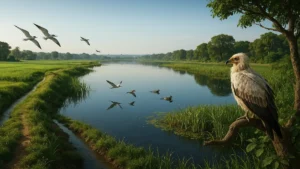Arunachal Pradesh, nestled in the northeastern part of India, boasts a vibrant cultural mosaic and unparalleled biodiversity. The Pakke Paga Hornbill Festival (PPHF) serves as a testament to this diversity, bringing together communities, traditions, and conservation efforts. Let’s delve into the intricacies of this festival, explore the Nyishi tribe, and uncover the conservation initiatives contributing to the region’s ecological balance.
Pakke Paga Hornbill Festival: Celebrating Culture and Conservation
Inaugural Year and Objectives:
- The PPHF, inaugurated in 2015, holds a unique purpose: recognizing the Nyishi tribe’s crucial role in hornbill conservation within the Pakke Tiger Reserve.
- Beyond cultural festivities, the festival aims to establish alternative income sources, steering away from harmful practices like hunting and logging.
- It serves as a platform for creating national awareness about the natural wonders of the Pakke Tiger Reserve and its surroundings.
2024 Theme: Domutoh Domutoh, Paga hum Domutoh
- Translating to ‘Let Our Hornbills Remain’ in Nyishi, this year’s theme emphasizes the imperative need for hornbill preservation.
- The theme aligns with the broader conservation goals, focusing on the iconic birds and their ecological significance.
Pakke Tiger Reserve: Nature’s Abode
Location and History:
- Geographically situated in the East Kameng district, the reserve, formerly known as Pakhui Tiger Reserve, was renamed in 2001.
- As a Project Tiger site, it spans 862 km², safeguarded by the Department of Environment and Forest of Arunachal Pradesh.
Flora:
- Encompassing lowland semi-evergreen, evergreen, and Eastern Himalayan broadleaf forests, the reserve hosts 343 woody species, including a rich assortment of orchids.
Fauna:
- With over 40 mammal species and 296 bird species, including the globally endangered white-winged wood duck, Pakke Tiger Reserve is a biodiversity hotspot.
- The reserve is also home to an estimated 500 butterfly species and various reptile and amphibian species.
Conservation Initiatives:
- The Nyishi community actively participates in wildlife protection, enforcing customary laws and contributing to the Ghora Aabhe Society, recognized for its conservation efforts.
Nyishi Tribe: Guardians of Tradition and Nature
Demographics and Language:
- As Arunachal Pradesh’s largest ethnic group, the Nyishi community comprises around 300,000 individuals.
- The Nyishi language, belonging to the Sino-Tibetan family, is central to their identity.
Social Structure and Practices:
- Polygyny, a prevalent practice, reflects social status and economic stability, although it is diminishing with modernization.
- Descent is traced patrilineally, and the community is divided into several clans.
Economy and Livelihood:
- Engaged in jhum cultivation, the Nyishi people cultivate paddy, maize, ginger, and various vegetables.
- Traditionally practicing a barter system, Nyishis value reciprocity in their economic transactions.
Nyishi Attire and Ornamentation: A Reflection of Tradition
- Traditional attire includes plaited hair with a brass skewer, cane rings, and distinctive headgear made from hornbill beaks.
- Both men and women adorn themselves with beads, metal disks, and cane garters, showcasing a rich cultural heritage.
Nyokum Festival and Religious Shifts
- The Nyokum festival, celebrating ancestral commemoration, is a significant cultural event.
- With the advent of Christian missionaries, the Nyishi people, once practitioners of Donyi-Poloism, have seen a shift in religious affiliations.
Conservation Challenges
- The traditional Nyishi practice of wearing hornbill beaks as part of their attire has inadvertently impacted the hornbill population.
- Organizations like the Arunachal Wildlife and Nature Foundation and the Wildlife Trust of India are working to halt hunting and protect hornbills.
Important Questions Related to Exams
- What is the theme of the 2024 PPHF, and why is hornbill preservation emphasized?
- Where is the Pakke Tiger Reserve located, and what makes it a biodiversity hotspot?
- How does the Nyishi community contribute to wildlife protection in the Pakke Tiger Reserve?
- What is the population and language affiliation of the Nyishi tribe in Arunachal Pradesh?
- What cultural shift has the Nyishi community experienced in terms of religion, and how has it impacted conservation efforts?
Kindly share your responses in the comment section.




 Chhattisgarh Gets Its First Ramsar Site:...
Chhattisgarh Gets Its First Ramsar Site:...
 Maharashtra Ends the Century-Old Pagdi S...
Maharashtra Ends the Century-Old Pagdi S...
 Maharashtra Govt Partners with Microsoft...
Maharashtra Govt Partners with Microsoft...







